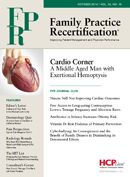Publication
Article
Family Practice Recertification
Bridging the Gap Between Provider Offerings and Patient Understanding
Author(s):
Even as Electronic Health Record (EHR) systems become more commonplace in the medical community there is still a large knowledge gap between health care professionals and their patients regarding the availability and use of these systems, according to a recent survey.

Even as Electronic Health Record (EHR) systems become more commonplace in the medical community there is still a large knowledge gap between health care professionals and their patients regarding the availability and use of these systems, according to a recent survey.
The survey results show that many patients either do not know that there is an EHR system available to them, or are unsure how to use them, resulting in many systems not being fully utilized.
This is an important issue for physicians to address, as patient participation is required for practitioners to comply with the Meaningful Use standards.
According to an article on technologyadvice.com, 40% of the 430 people surveyed said they were unsure of any patient portal system used by their doctors. The survey results also revealed that less than half of that group whose physicians used a portal had been made aware of it. More than half also said even if there was a system available for them to use, their doctors never followed up to encourage them to use it.
The study also showed that there is a generational gap between patients with regards to technology use in health care. For many people the preferred way to set an appointment with their doctors is the traditional phone call, with the 18-to-24-year-old group slowly moving toward digital appointment scheduling. Many patients surveyed (just over 42%) said they still preferred getting test results over the phone, while 18% preferred e-mail and 14% wanted another form of digital message.
Utilization of the systems may not be total by practitioners yet, but the results of the survey showed that just 11% of patients surveyed said their doctors outright “did not” have a portal available to be used.
“This suggests that either the majority (50.9%) of primary-care physicians do not have a patient portal (which is unlikely given the high EHR adoption rates of primary-care physicians, the
Meaningful Use Stage 2 Incentives, and the rates reported by private healthcare organizations), or physicians are failing to effectively communicate to patients that such tools exist,” the authors noted.
In looking at the results, the authors also saw hope for greater implementation of these systems in the future.
Based on these responses, “it appears physicians need to invest more time and resources in educating their patients on the availability of patient portals,” they said. “Creating in-office orientation programs to walk patients through the portal site would likely reduce the large number of uninformed patients.”
One area where the authors said they were most surprised by the results was in the lack of follow-up communication by providers considering the potential benefits from meeting the Stage 2 incentives. Taking a closer look, they said 23.5% reported a follow-up by phone, while just under 13% reported getting a letter and just 9% reported getting information directly from the portal. Out of the total group surveyed just over 5% said they did not want any follow-up from their doctors after an appointment.
“These results suggest there is large room for improvement in post-appointment patient engagement strategies,” the authors wrote. “Physicians are likely missing out on a key opportunity to encourage patient portal usage by failing to orient patients to such online resources, and then failing to provide incentive for them to log on to the platform.”
As EHRs become more commonplace, the authors said both doctors and patients will find them to be more valuable.
“By investing more resources and time into such initiatives, physicians will likely be able to raise their patient portal engagement rates, meet Meaningful Use Stage 2 requirements, and cultivate greater acceptance of online portals in their patient populations.”






